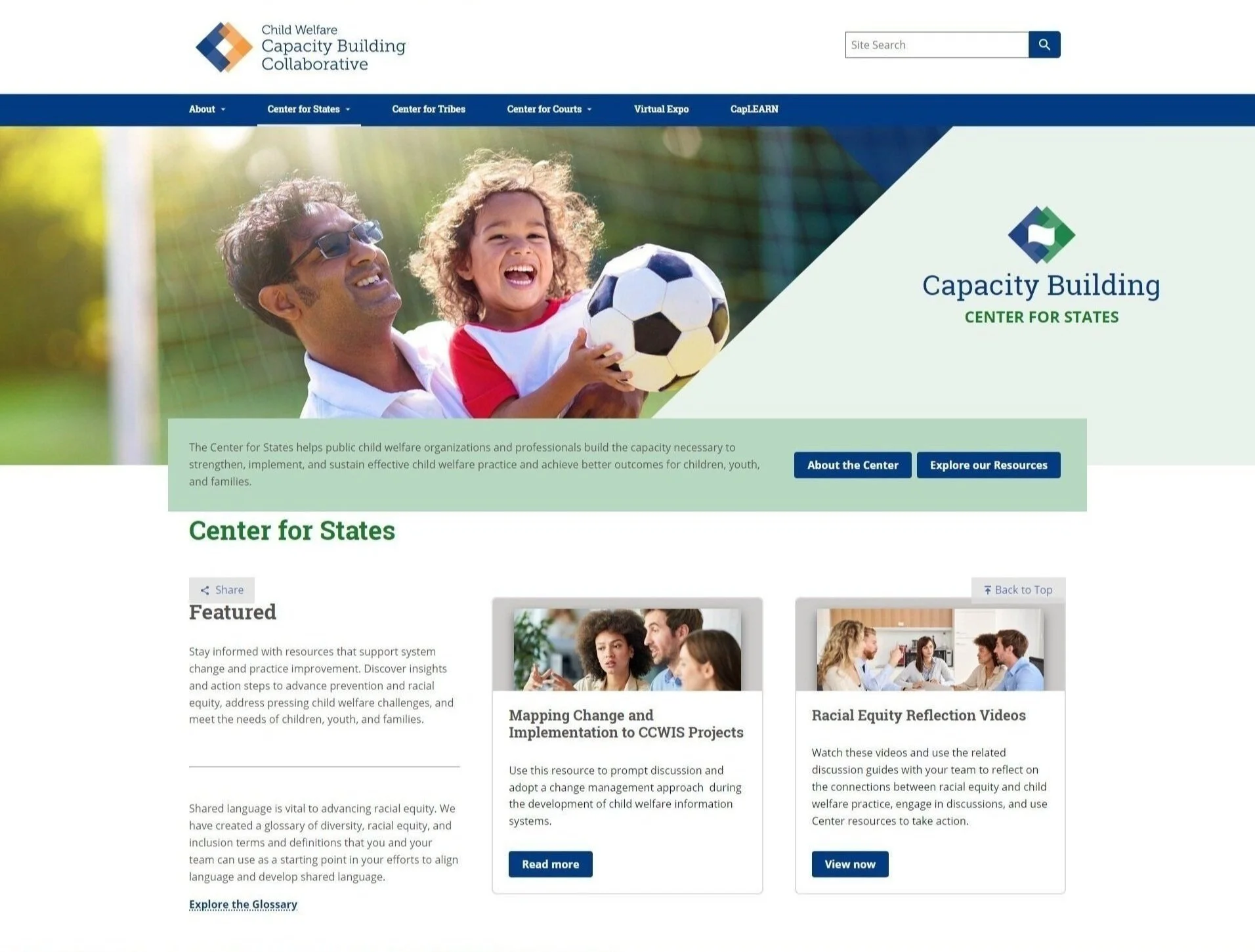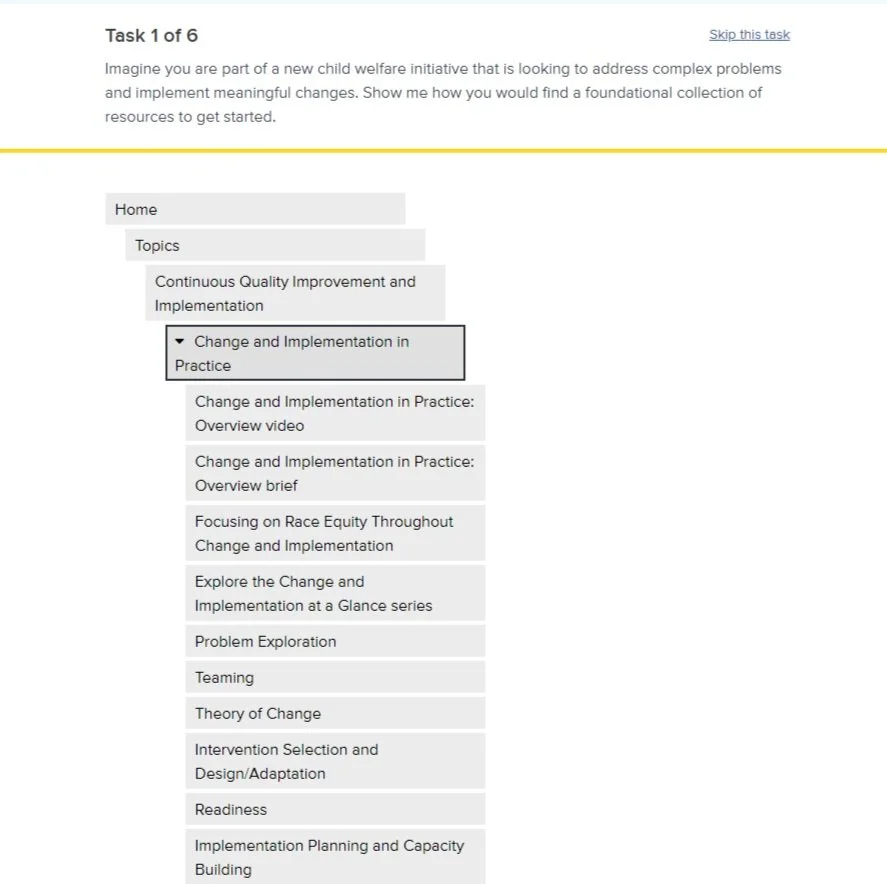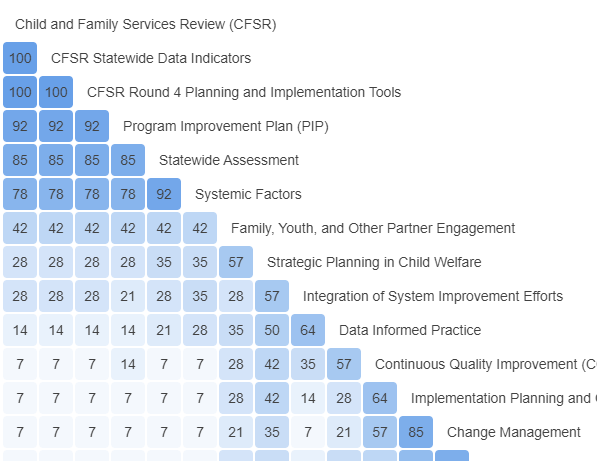UX RESEARCH - P01
Center for States
-
A multidisciplinary team of UX Strategists, UX Researchers, and Content Specialists collaborated to enhance the main website for the Capacity Building Collaborative. This platform serves as a key resource hub for child welfare agencies, supporting management, review preparation, and access to essential tools.
-
Served as a UX Researcher and UX Designer.
Skills used: website assessment, writing, workshop facilitation, tree testing, card sorting, feedback analysis, wireframing.
Methodology
After a thorough assessment of the site, the research team selected three primary methods to evaluate usability and improve resource discoverability.
Heuristic Evaluation – A structured expert review of the site using a range of assessment criteria.
Tree Testing – An unmoderated test where users complete navigation tasks using the existing site map.
Card Sorting – An unmoderated test where users organize content labels and terms into alike categories.
Heuristic Evaluation
The research team conducted an expert usability evaluation of the site, focusing on five key criteria: Navigation & Organization, Layout & Presentation, Content Labeling, Search Optimization, and Accessibility.
Our assessment identified several areas for improvement, with Navigation and Organization emerging as the top priority to enhance resource discoverability and user experience.
Key Findings
Main Navigation Menu: Labels were long and unclear, requiring a streamlined re-organization for better usability.
Page-to-Page Navigation: Most pages lacked secondary navigation, making it difficult for users to track their journey, retrace steps, or efficiently explore resources.
Page Layout & Information Architecture: Pages containing multiple resources lacked structure, consistency, and visual contrast, making information hard to locate.
Additional Enhancements: The team identified low-priority improvements that could further enhance navigation over time, including footer links, breadcrumb refinements, and removal of competing UI elements.
Following our evaluation, findings were categorized by priority, guiding the client in determining which usability enhancements required immediate action. Among these, site navigation challenges stood out, leading to the next phase of research: Tree Testing.
Tree Testing
Recruitment: The research team identified candidates through the Center of States team, aiming for at least 30 participants—preferably those who could complete both the tree test and card sort. Participants needed uninterrupted access to the internet for remote testing sessions.
Test Set-up: Collaborating with a content strategist, the team recreated the existing site map in Optimal Workshop, the platform used to conduct the remote testing. To address additional navigation-related questions beyond what the tree test could measure, a short optional questionnaire was included at the end of the test.
Results & Key Insights
The test validated key issues uncovered during the heuristic evaluation, particularly around navigation challenges.
It highlighted which resources were buried within the site, making findability and discovery challenging for users.
Data provided insights into user search behavior, including the number of attempts needed to locate a resource.
The results also offered partial clarity on how page labeling influenced navigation efficiency.
^Tree Test Sample - Optimal Workshop
Card Sorting
The site’s resource library was designed with a tagging system, that doubled as filters options, to improve searchability by linking related resources. However, research revealed that the resource library was underutilized, with users reporting an overwhelming filtering experience. To refine the tagging system, the team conducted a card sort to assess user interpretation, grouping patterns, and expectations for content labels and filters.
Results & Insights
The findings revealed which words were commonly associated, offering valuable input for the Center of States content strategy team.
Users assigned titles to the categories in which they sorted labels, offering deeper insights into their category labeling expectations.
The team ensured findings were presented responsibly, emphasizing limitations and contextualizing results for informed decision-making.
^Card Sort Results Sample - Optimal Workshop
Presenting Findings
The final report was structured into three sections:
Combined Findings – A synthesis of insights from usability tests and assessments, filtered to highlight high-impact findings. Presented in clear and concise language.
Suggestions – High-level wireframes visually illustrating identified issues and proposed solutions, reducing the need for lengthy descriptions. This method helped the client better visualize improvements without excessive documentation.
Appendix – Supporting materials, including low-priority findings, detailed tree test and card sort results, and future UX enhancement recommendations.
The client requested a comprehensive report consolidating all research findings. However, balancing detail and clarity while avoiding an overwhelming volume of information posed a challenge.
To ensure alignment with client priorities, the research team hosted a workshop featuring ranking exercises. These exercises helped clarify which findings required the most detail based on client needs and Lower-priority insights that could be summarized or omitted.





